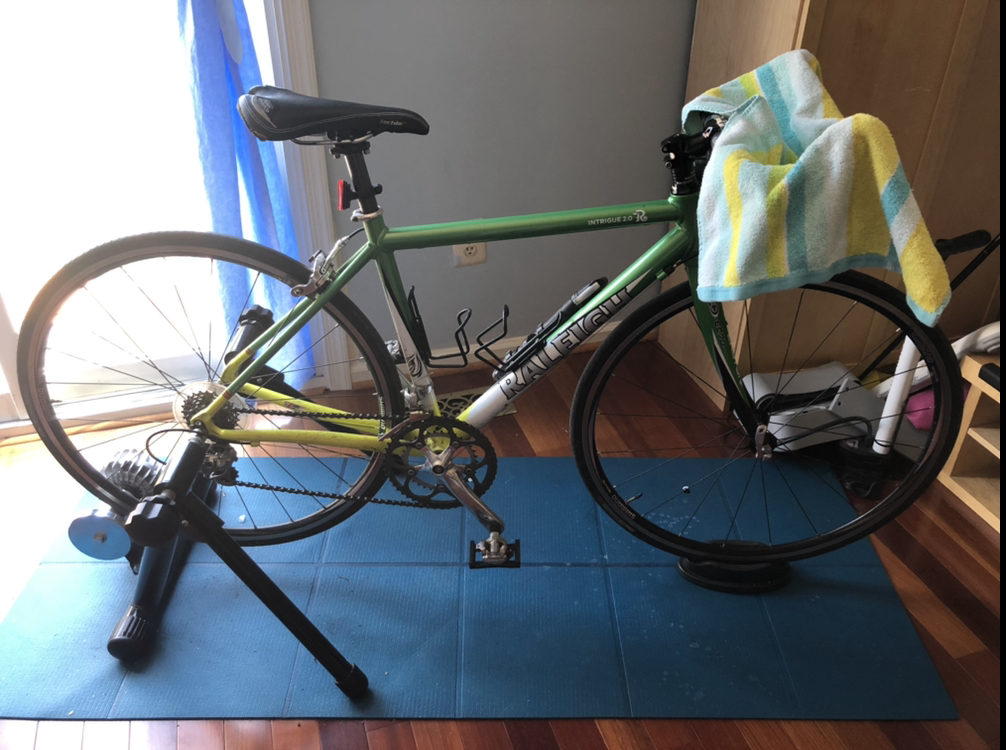
I think most cyclists have the same gut reaction to indoor biking as runners have to treadmills. After all, what can beat the feel of wind on your face and seeing all those beautiful views? Well, not getting rained on, not slipping on ice, not getting hit by a car… 😉 So yes, indoor trainers and spin bikes can have a place in your training routine as well.
Whether you are talking about a bike trainer or an indoor bike, you can rely on it to keep you safe from cars or bad weather. For most of us, at least one of these is an issue. Since I ride mostly on bike trails, cars tend to be lower level problem for me, but they are a concern. If you are a beginning cyclist, getting on the road may be intimidating. Indoor trainers and stationary bikes can be a great place to start. The weather can be a whole another thing. It’s been windy in here for the past few months and the heat is going off the charts. There are also: monsoon storms, ice, snow, fog… Well, you get the idea: mother nature may make it severely unpleasant, if not impossible, to go outside for a ride. Indoor cycling to the rescue!
That’s the main benefit you can read about online. There is a couple of additional benefits I can see to being able to hop on a bike at home any time. Top one: it’s easier on your schedule, especially when family responsibilities keep you at home. I tend to enjoy my indoor trainer while my daughter is asleep. It also keeps you close to home in case of problems and emergencies. Sometimes, I worry that if I get on a bike, I won’t be able to get back in time for a meeting or what if I have a problem (like a broken seat, which happened earlier this season or a flat). You can’t always afford that time-wise, so indoor trainer would be your go-to.
Another consideration for stationary bikes: when you are travelling, the hotel gym (or gym you have membership to) will most likely have a stationary bike. Traveling with your own bike may not always be an option, so alternatives are welcome.
In short: indoor trainer or stationary bike make for a great back-up plan!
Now there are also some additional benefits to both. For example, you can do one leg exercises to gain some strength. It’s a lot safer when your bike stays upright regardless of what you do! You can also set up your training the way you want, hills, flats, whatever. When you ride outside, ‘you get what you get and you don’t throw a fit’, as kindergartner’s mantra says. Sometimes you need to work on something specific and it’s easier to have a targeted workout on an indoor trainer or a stationary bike. Oh, and you get more of a workout, since you don’t get breaks on downhills or anything like that!
Now there are some clear disadvantages to biking inside. You don’t get to experience the weather and the terrain, which can be quite a disadvantage when you go riding outside. Sun beating on you is really not something you can simulate at home. However, stationary bikes tend to be plagued by lack of air flow. I have seen plenty of Instagram pictures of people surrounding themselves with fans. Personally, I put mine next to the AC vent. Either way, make sure you have air to breathe! Oh, and water. Apparently many people forget to bring water to those workouts. I’m not one of them, so I can’t really relate. But yes, always make sure you are hydrating properly.
Another issue: BOREDOM. It’s easy to get bored peddling alone, staring at the wall. Personally, I enjoy watching movies when I’m on my indoor trainer, so in a way, I’m turning lack of visual stimulation of the road into an advantage: I reward myself with something to watch, which can keep me in the seat for longer than I would otherwise want, since I have to know how this ends! (like you don’t know the feeling!)
It’s easy to cheat when you bike at home: you can make all the settings so easy on yourself and think you are getting great workout, while in reality, you wouldn’t have gone more than a block. I guess that’s what makes using an indoor trainer with your regular bike great: you will know what your effort is and you can adjust based on that. Here is one way that an actual stationary bike may be better than an indoor trainer: you can set up a specific course or manipulate settings, adding variety to your training. I don’t know too much about various indoor trainers, but the only variations I can get while I’m riding, I am limited to gear changes. So that’s one for the stationary bike over the trainer!
Although it’s not like the stationary bike is all the way better than an indoor trainer. For one thing: do you have room to always keep a stationary bike right there? Personally, I don’t. Indoor trainers are lighter and easier to put away. They are also cheaper. The expensive part, after all, is the bike. And that you already had. It also doesn’t require going to the gym (in case you are opting for somebody else owning the stationary bike 😉). Indoor trainer allows you to train on your own bike, with all the correct settings and measurements and your bike shoes properly clipped in. On the other hand, indoor bikes may be of the reclined type, which helps if you are having back problems. I also used to find the wider seats easier on my butt.
There is one more thing to say for stationary bikes that most websites refer to: spin classes. A lot of people think of those when they are discussing advantages of stationary bikes. Those have some advantages, such as company of other people and they tend to be on a schedule, which may help you stay on top of it. On the other hand, I have never cared for the noise and being stuck in a room full of sweating people (regardless of how well ventilated the room is).
So should I use an indoor trainer? A stationary bike? Yes! Even a short, easy workout at home when circumstances won’t allow you to ride outside is better than nothing. There are also specific things you can focus on during those workouts. But at the end of the day, nothing can beat hitting the road!
